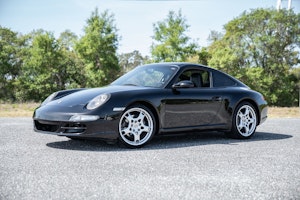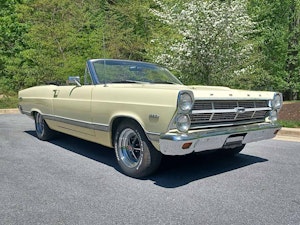Media | Articles
Everrati Pagoda: A Sensible Blend of Classic and EV
Re-imagined, redefined, future-proofed. These are the words most often used to describe the ever-growing number of electrified classic cars.
They’re words that serve as bait to the devout petrolheads for whom implanting an e-motor and battery in place of a combustion engine are tantamount to treason, but, dare I say it, certain classic cars are not defined by their power units. I’d argue that the Silent Classics Fiat 500 I drove last year lost little and gained plenty in its electrification, for example.
Justin Lunny, boss of Everrati, feels the same. “In so many cars their engines weren’t the best thing about them, and their transmissions weren’t the best thing about them. The reason all of our Porsches start life as a low mileage Tiptronics is because no one wants a Tiptronic!”
So, as a rather lovely Le Mans Blu 1968 W113 Mercedes-Benz SL Pagoda awaits, I wonder how this fits with the ethos.
“We’re not after the Holy Grail cars. In fact the Pagoda started out as a 230 manual, which again, was not really the Holy Grail of Pagodas.”
Marketplace
Buy and sell classics with confidence
What’s more, the car was a mess, with a previous restoration attempt having gone awry, and pretty much every panel requiring replacement. Of course, its owner could have restored the powertrain alongside the body and interior, but instead opted for electrification to go along with a comprehensive rebuild.
As we’ve come to expect, the standard of craftsmanship and attention to detail from Everrati is second-to-none. This example was taken back to bare metal, anything resembling rust was removed and replaced with fresh steel and then lavishly painted.



The interior had a total retrim with period-correct Cognac MB-Tex fabric, although Everrati’s partner Bridge of Weir can supply custom leatherwork as desired. It requires a keen eye to spot where the modifications for the electric powertrain have taken place, but on startup a small central digital display goes through a little test routine before allowing progress. The right-hand dial has been recalibrated to show power output rather than engine revs, while the left maintains its role as speedometer.



The gear selector looks a lot like a manual, but only shifts fore and aft to select drive or reverse, and while different calibrations of regenerative braking can be offered, about 95 percent of stopping power in the current setup comes from the big brake pedal.
Next to it, the organ-pedal accelerator requires more travel and effort than I expected to get the SL rolling. It’s a deliberate bid to mimic combustion-style pickup rather than the instantaneous acceleration of today’s EV, and with time, I’m sure it would be easy to get used to.
Meanwhile, the electric-assisted steering requires almost no effort at all, again in keeping with the car’s character.
Adding the electric powertrain, which includes a 300-hp Helix motor of the type fitted to the Lotus Evija and a choice of 54 or 68 kWh battery, ups the SL’s weight by around 220 lbs. Accordingly, the springs and dampers are uprated to cope with the extra mass and maintain a period-correct ride height.
Everrati says that the smaller battery can deliver 160 miles of range and a 0-60 mph time of less than eight seconds, while the larger capacity increases driving range to over 200 miles while cutting the 0-60 by a second.

Not that there’s a chance to put any of these claims to the test, as my drive takes place in the grounds of the Wormsley Estate, a 900-year-old stately home just west of London, and I have to share the narrow lanes with flocks of freshly-shorn sheep. At least I’m not likely to disturb the cricket match with the sounds of internal combustion.
It’s not exactly silent, however, with quite a lot of whine from the differential, that’s all the more noticeable for the lack of intake and exhaust. The car is still a bit of a work-in-progress so this may well be better contained by the time it’s delivered to its owner.
But who are these customers willing to commission a £330,000 ($414,000) electro-mod such as this? “We were at Pebble Beach and one chap, a collector, was sat there looking around over the lawn at Pebble. And he said, ‘I’m not sure I want to be doing this anymore’. And I said, why is that? He said, ‘Well, I’ve got kids, I’ve got grandkids and this is really a celebration of combustion and I’m not sure we should be doing it.’”
Lunny says there were plenty more like him, with more than a thousand people requesting further information.
“We create cars for people who have gone EV but still love cars. A lot of our clients have had multiple EVs, principally Teslas in the main, but they still love cars. And actually, this is a way to be cool, be sustainable and have something that’s really exciting.”
***
Check out the Hagerty Media homepage so you don’t miss a single story, or better yet, bookmark it. To get our best stories delivered right to your inbox, subscribe to our newsletters.



















Shame how good cars are behind destroyed.
Let’s see. Eco friendly, better performance, better reliability. Yeh, real destruction.
Agreed this is destruction.
The manufacture of the batteries alone probably emits more carbon than the original car would in 30 years, since collector cars are driven so sparingly. The total emissions from all classics is negligible – it’s nothing. Converting them to EVs is not greener.
Electrical conversion is today what a T bucket was in the 1970s or the ZZ top hot rod was to the ’80s. In a short time, these electric conversions will be outdated customs. Some may still covet a ’70s T bucket or Boyd Coddington wheels on their hot rod, but that market is FAR smaller than for original cars. This is especially true with electric drivetrains, which are in their infancy – in a decade or two the current electric drivetrain conversions will seem as antiquated as a Model T magneto ignition system does today. An original car is timeless and has appeal indefinitely while customs rarely age well
I had a 1968 280SL some years back. It was gorgeous, but mechanically, not so impressive. Every time I so much as sat in it, it cost me $500, I didn’t even have to start it up. Rust problems, brake problems, mechanical fuel injector pump problems, the top leaked and filled the rear footwells with water every time it rained, you would almost think this was a British car . . .
These days I have a 2008 CLK 350 – amazing what four decades of improvements will do. Now if I could have the CLK 350 running gear and reliability in the 280 SL package, that would be perfection.
Sensible? Since when is $414k sensible. I’m sure the weight gain provided “road hugging weight” as Jay Leno likes to say.
Wonder what swtiching in a complete Honda S2000 drivetrain would cost. That would be a neat car. $414k is nuts.